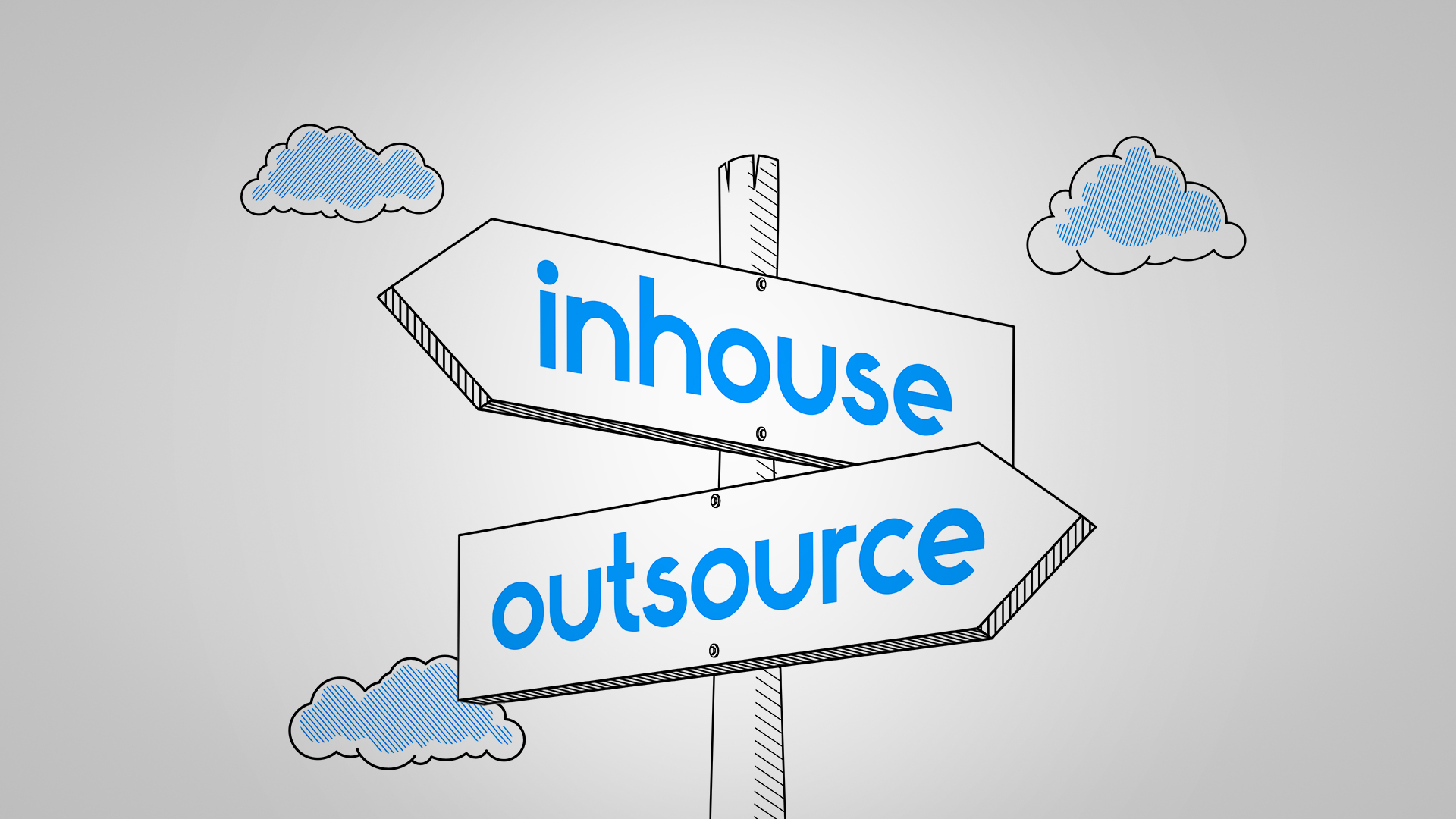
When In-House Marketing Makes Sense: An Ad Agency POV That May Surprise You
For many years brands, and not surprisingly, the advertising industry shared the opinion that it was between difficult and impossible to bring the services that a traditional marketing agency provides “in-house” to the client company. There was pretty good evidence that this was the third rail of advertising. Many large companies tried to build in-house agencies only to shut them down or struggle as the quality of their marketing mysteriously slumped. However, today there are some pretty compelling success stories for in-house agencies (IHAs). So, we thought rather than ignore this truth, we would have a closer look.
In today’s edition of Plain Talk, we’ll help you examine what conditions might be necessary to succeed in in-house marketing. We’ll explore what you gain and lose and whether in-housing might be for you.
- In-House Marketing Is Not a New Idea
- Motivations for Building an In-House Agency
- 4 First Steps for Successful In-House Marketing
- Get Expert Help With Outsource vs In-House Marketing Decisions
In-House Marketing Is Not a New Idea
According to researcher Marsha Appel writing for the American Association of Advertising Agencies (4As), businesses have been looking for ways to successfully integrate ad agency services into their internal marketing departments for nearly 100 years. Originally driven by the mythical 15% commission that was generally the sole source of income for an ad agency, businesses seeking to cut costs thought in-housing was a viable solution.
However, a bunch of issues surfaced with this idea. Not the least of which was that media outlets would not cooperate with businesses who wanted to buy their media directly at the same discounts offered to agency clients. That contributed to the problem in the 50s and 60s. Yet, the 15% commission has been (mostly) dead for at least 20 years. So, why has it been such a struggle to in-house in the twenty-first century?
In-housing can work
Yes, an agency guy said that. The truth is that for years in-housing did not work or work well. However, in the last decade or so, some really excellent in-house capacities were born. The Hershey Company, AT&T, Bank of America, Ally Bank, and Frito-Lay, just to name a few. All operate smart, strategic, creative in-house shops. The idea that nobody worthwhile would work in an in-house agency is also dead. This is proven by blue-chip creatives with the help of in-house shops. For example, Robert Wong at Google Creative Lab and Sue Anderson at Creative X (Instagram). So, knowing this is a growing trend, why might you consider building an in-house shop for your brand?
Motivations for Building an In-House Agency
When thinking about the potential for success (or failure) of in-housing, it might be helpful to first look at what motivates companies, maybe even companies like yours, to consider building an in-house agency. While there may be others, we believe the top motivations are:
- Results: The idea that ad agencies are not driven by business results but rather by less accountable “top funnel” metrics.
- Savings: The idea that a company can save substantially on marketing costs by directly hiring staff to replace its agency.
- Fit: The idea that an ad agency does not really “understand my business,” so how can it possibly succeed in helping me grow?
Let’s take a look at each of these to see if in-housing might make sense for your business.
Results: My agency doesn’t care about results
While it seems like this should no longer be the case, we get that it can happen. Some agencies continue to focus on top-funnel metrics like “awareness” rather than on the impact of marketing on sales, profit, and attribution. In reality, though, many agencies have become great at measurement and attribution beyond top-funnel metrics. If you are willing to share sales data with your agency, they should be tracking marketing impact and attribution. If you have an agency that isn’t actively seeking to measure its performance, you probably just need a new agency, not an in-house agency.
Savings: In-housing your agency to save money
This is by far the most common reason we hear from friends and clients who are considering in-housing their agency services, and for some brands, it can actually be true. A typical ad agency charges an hourly rate for each hour worked by a billable person on their team. That hourly rate is somewhere around 2.25 to 3 times the salary of that employee. Whoa, three times? But built into that cost are things like benefits, software, overhead, etc., as well as a profit (net margin). Depending on what source you look at, the average agency profit runs between 6% and 25%.
This means assuming you like the kind and quantity of services you get from your agency, the real savings opportunity is pretty much the agency’s profit margin. This assumes you will pay your in-house agency market rate and give them benefits and such. For a company with a $1,000,000 agency fee marketing budget this looks a lot like an opportunity to save between $60,000 and $250,000 in agency fees.
So, what are the potential pros and cons?
Pros
Co-location
Now, your agency works from your offices and has greater exposure to your culture, products, and systems. This can save time and streamline deliverables. There is a lot of truth to this, but at the same time, the increase in off-site workers caused by the pandemic (and contributing to the growth of in-housing) is eating into the value of co-location as a motive.
Salary savings
Remember that 6% to 25% we mentioned above? If your brand is able to swap its fee costs for the same or better in-house marketing capabilities, this seems very compelling.
Cons
In-house agency startup costs
Sadly, the computers, desks, software licenses, etc., that you will need in order to replace your agency are not free. Between creative software licenses, research software, insight tools and subscriptions, digital tools, data subscriptions, project management software, SEO tools, a data visualization suite, PR tools, social listening and management software, analytics tools, and other useful toys, your agency is probably spending $200,000 to $500,000 (or more) each year on tools used for your benefit (but amortized across multiple clients). If you are considering going fully in-house, you’ll have to pay for them or go without.
People
This can be tricky to nail down. Think of it in terms of full-time equivalents (FTEs). For one skill, say copywriting, you may be able to hire one great writer for what you were paying your agency for copy. But it’s likely that your agency had five or six writers working on ideas before they came up with the right one for you. That one FTE was really 20% of five people.
I have personally met three writers who all claim to have written Southwest Airlines’ famous “You are now free to move about the country” line. No doubt, they all played a role, but the process of getting to a great campaign idea is rarely a single person’s work. This is, of course, true of creatives, strategists, PR, and social media people. This may be one of the greatest risk factors for small and midsize businesses that are considering in-housing.
Capacity
Parallel to the question of people is that of capacity. According to a study by the In-House Agency Forum (IHAF), 82% of in-house agencies say they are under-resourced for busy times. This means they must reach out to agencies or freelancers to augment their ability to complete projects. While the option to reach out to freelancers or agency partners solves the brand’s short-term need to “flex,” project work can come at a premium, as can rush work. You may also have agency resources working on your business that need to be onboarded to your brand. All normal, of course, but can eat away at the in-housing benefits like co-location. In fact, according to a study by the World Advertising Federation, as reported in The Drum, some 95% of companies with in-house agencies still use external ad agencies as well.
That’s not to say there are no situations where in-housing can save money. Clearly, there are, but they appear to depend on the size and scale of your marketing operation. Simply put, if you have a really big marketing budget and a correspondingly large agency fee, in-housing might be financially right for your brand. The challenge is greater with small and mid-sized organizations. You might give up in depth and breadth of talent, capacity, and expertise, which may not be a good value for the brand.
Fit: Understanding your brand, business, customers, and culture
Fit is another brand desire that can drive in-housing. This motivation is about having agency resources that understand your culture, your brand, the business the brand is in, and the customer the brand is seeking. On the surface, you’re probably saying, “Yeah, that’s what agencies are supposed to do,” and you’d be right. While not all agencies are the same, we are seeing significant growth in specialty agencies (agencies that focus on a few or even one business vertical or skill) specifically to answer this need clients feel to have industry specialists, not just marketing specialists, working for them. And you could argue there are some real advantages.
Pros
Believers
The primary “fit” benefit of an in-house agency team is that it will be fully immersed in your company and brand culture. It should really “get” your brand, business model, customers, products and how your company operates. This can be incredibly valuable to how your team works and can positively impact the authenticity and effectiveness of your marketing activity and messaging while eliminating process friction. However, the best companies will tell you that this does not just happen by osmosis. Rather, a combination of onboarding, training, and the positive impact of working for a company over time appears to be what produces “fit.” If you are struggling to decide on in-housing based on this issue, consider whether or not you have onboarded your agency partners like you would a teammate.
Cons
Groupthink and politics
While there have been some really great marketing communications from in-house agencies recently, there have been some truly awful ones as well. Famously, Facebook’s in-house agency Creative X released a six-minute video introducing the rebrand for Meta. The video led to Facebook’s “trustworthy score” per Harris Brand Platform dipping 6.2%. Most experts blame the use of CEO Mark Zuckerberg as a significant contributing factor. In this case, the desire to support (or suck up to) the boss led to a seriously bad marketing decision.
Building an in-house agency requires a culture that allows the agency to “speak truth to power.” Groupthink and politics can also lead to an unfortunate lack of objectivity about the market and your competitors. If your company culture does not allow team members to speak openly or even with admiration about a competitor’s great marketing, you are putting your company at a disadvantage.
Legacy thinking
The cousin to “groupthink” is legacy thinking. You may have heard the phrase “But that’s not how we do things around here” or “We tried that once, and it didn’t work.” That’s legacy thinking, and it can hobble a company’s marketing innovation and cause them to miss out. For an in-house agency to flourish, it is critical that your culture supports and promotes people who work outside of their comfort zones. Why? Because that’s where innovation happens. If your company culture is not up to the task of fighting legacy thinking, it’s worth knowing that many marketing agencies will tell you that their survival depends on their ability to innovate and to help clients adopt new ideas, strategies, and technologies that will aid growth.
4 First Steps for Successful In-House Marketing
Creating an IHA is a big and bold step for the right brands. If you believe your business has the culture and budget to achieve success with in-house marketing and want to pursue building your own team, here are four things you can do to start the process off right.
1. Hire (or promote) an expert and empower them.
Many successful in-house agencies began with a single expert or visionary who was given the mandate, budget, and authority to build an in-house agency. An IHA isn’t just about getting HR to find creatives for you. Having a dedicated leader to determine the mission, values, process, and required skill set will help make sure your agency is built on a strong foundation.
2. Cherry-pick roles.
Determine the most effective and profitable roles for your in-house agency. It’s possible, even likely, that your in-house agency should be built from the ground up to collaborate with outside agencies. As we mentioned previously, 95% of brands with an IHA still work with outside marketing services companies. Your existing agency probably has valuable institutional knowledge of your business and vertical. This knowledge may make them a great partner moving forward. Don’t be afraid to discuss in-housing with your existing partners. They may have some great contributions.
Also, consider things like speed and specialization as factors when deciding what to move in-house.
- For example, if you have an e-commerce website that requires constant updating, an in-house “content pop” person will be a great addition to your IHA team. If your company has a lot of sales support needs (PowerPoint decks, small-batch brochures, etc.), an in-house designer would be a great choice.
- Regarding specializations, some critical functions are not daily-use services. Large-scale custom research, web coding, and strategy functions (creative, traditional media, etc.) may not be good value in the form of a full-time equivalent on your payroll. Plus, an agency partner may give you access to more resources and tools to “flex” for these roles when you need them.
3. Network with existing marketing partners.
In addition to collaborating with existing marketing partners to help you build the best in-house capabilities, take advantage of the experience of others who have gone before you. Join organizations like the In-House Agency Forum (about $3,500 per year) or the In-House Agency Committee at the Association of National Advertisers (ANA costs vary). Both of these offer resources, seminars, and networking opportunities with companies that have successfully built an IHA.
4. Ease into the transition.
When you do flip the switch on your IHA, you want everything to go smoothly. Consider overlapping IHA services with your previous provider. The short-term costs will mean you have to defer some of the savings generated by your IHA. However, your business needs won’t change.
Get Expert Help With Outsource vs In-House Marketing Decisions
Deciding between in-house or outsourcing your marketing can be daunting. However, it’s always possible to outsource some aspects of your marketing strategy while keeping others in-house. The team at PriceWeber can provide valuable insights to help you find the perfect balance.
Let’s work together to craft a solution that fits your unique business needs. Contact us today or call us at 502-499-4209. We’re happy to help!
Our Articles Delivered
Signup to receive our latest articles right in your inbox.




